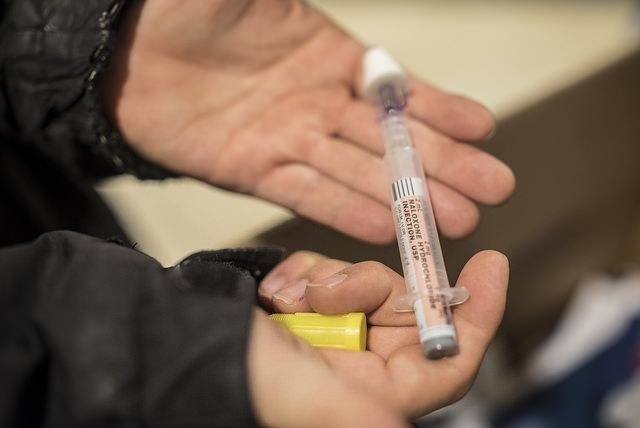
King County drug and alcohol deaths rose 9.5% in 2018
415 residents succumbed: Heroin and opioids, including fentanyl, continue to be most common drugs linked to fatal overdoses.Media Contact:
- King County: Sharon Bogan - 206.263.8770, Sharon.Bogan@kingcounty.gov
- UW Medicine: Brian Donohue - 206.543.7856, bdonohue@uw.edu

Drug and alcohol use caused the deaths of 415 King County residents in 2018, up from 379 in 2017, according to two new reports published today by Public Health – Seattle & King County and the University of Washington’s Alcohol and Drug Abuse Institute.
Data from the 2018 Overdose Death Report describes drug and alcohol-caused deaths investigated by the King County Medical Examiner’s Office. The office reported that in 2018, 77% of drug and alcohol deaths involved multiple substances. In recent years, overdoses from prescription opioids and heroin have remained stable while overdoses involving methamphetamine and illicitly manufactured fentanyl compounds have increased.
Heroin and opioids, including fentanyl, continue to be the most common drugs associated with fatal overdoses (67%), while deaths involving methamphetamine continued to rise sharply at an alarming pace.
The annual Drug Trends Report, also published today by the UW Alcohol and Drug Abuse Institute, provides context about the changing nature of drugs' impact in our community.
Findings from the reports include:
- While opioids are the most common drug class in fatal overdoses, the majority of overdoses involve multiple types of drugs. Deaths involving both an opioid and a stimulant, such as cocaine or methamphetamine, increased from 45 in 2009 to 130 in 2018.
- Methamphetamine-involved deaths increased sharply over the last decade, from 21 in 2009 to 163 in 2018.
- In 2018, fentanyl-involved deaths doubled their 2017 total. This appears to be predominantly due to illicitly manufactured fentanyl.
- Overdose disproportionately affects men, and 16% of overdoses were among persons experiencing homelessness.
- The estimated rate of drug and alcohol-caused deaths was 22% higher among Blacks and four times greater among American Indian/Alaskan Native than among non-Hispanic Whites.
- The trend of increasing fentanyl-related compounds involved in deaths mirrors local police evidence-testing results.
- Use of medications to reduce opioid-use disorder is increasing substantially across the county.
- Syringe exchanges continue to expand the services they offer, including medications for opioid-use disorder and the number of syringes distributed increasing from 7.1 million in 2017 to 7.9 million in 2018.
- Testing of Seattle’s sewer water continues to indicate one of the highest levels of methamphetamine measured, compared with 96 other cities in 26 countries.
Providing access to medication-assisted treatment is the most important way to help those at risk for a fatal opioid overdose. Across our region, access to low barrier treatment such as buprenorphine has improved. There are now more than 100 locations across King County where people can receive medication for opioid-use disorder.
Distributing naloxone and reversing overdoses: During the past two years, King County has increased access to naloxone among law-enforcement officers, treatment providers, and directly to citizens through needle-exchange sites. In 2018, more 20,000 naloxone kits were distributed and at least 2,235 overdoses were reportedly reversed using naloxone. (The total is likely higher.)
What you can do to reduce the risk of overdose in our community:
- If someone is overdosing, call 911. If you are trying to help in an overdose, the Washington state "Good Samaritan" law protects you and the overdose victim from drug-possession charges.
- Carry naloxone, the medication to reverse an opioid overdose. Visit Stopoverdose.org for locations that provide naloxone.
- Get rid of unused or expired medications. Find a dropbox near you. www.medicinereturn.org
- If you are concerned about substance use of friends or a family member, the Recovery Hotline is a good place to start. Medication is available in the community that can cut overdose risk in half and treat urges and cravings. Call the 24-hour help line: 866.789.1511.
Stakeholders' quotes:
- “Drug and alcohol-related overdoses are a major public health problem. As we work to provide access to critical treatment to prevent overdose deaths, we also need to continue to work upstream to address the drivers of substance abuse, including adverse childhood experiences, trauma, poverty, racism, discrimination and homelessness.” — Dr. Jeff Duchin, Health Officer for Public Health – Seattle & King County
- “We are working to provide access to treatment resources in non- traditional settings to meet people where they are. In the last year, we have doubled the number of places where people can access help and support. By expanding access to resources in hospitals, needle exchanges, jails, and in the community, we hope to provide even more access to treatment to individuals who are vulnerable and susceptible to overdose.” — Brad Finegood, Strategic Advisor for Public Health – Seattle & King County
- “We need to recognize that people continue to use drugs such as methamphetamine because, in the context of their lives, drugs provide one way to manage challenges they face every day. Drugs may serve as an appetite suppressant when people can’t afford food, or lessen the negative impacts of current and past trauma by providing a temporary boost in dopamine to make someone feel good. Part of the solutions we must pursue include improving the circumstances of peoples’ lives, while increasing access to comprehensive services.” — Caleb Banta-Green, principal research scientist at the UW’s Alcohol and Drug Abuse Institute
Relevant links:
- Public Health – Seattle & King County’s Overdose and Response protocols
- Overdose dashboard
- Overdose-prevention resources at stopoverdose.org
- Treatment resources available through the Washington Recovery Helpline
- Heroin and Prescription Opiate Addiction Taskforce
For details about UW Medicine, please visit https://uwmedicine.org/about.